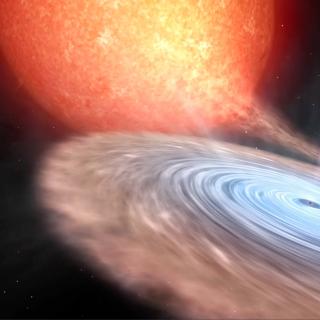Bibcode
Nieder, L.; Clark, C. J.; Bassa, C. G.; Wu, J.; Singh, A.; Donner, J. Y.; Allen, B.; Breton, R. P.; Dhillon, V. S.; Eggenstein, H. -B.; Hessels, J. W. T.; Kennedy, M. R.; Kerr, M.; Littlefair, S.; Marsh, T. R.; Mata Sánchez, D.; Papa, M. A.; Ray, P. S.; Steltner, B.; Verbiest, J. P. W.
Referencia bibliográfica
The Astrophysical Journal
Fecha de publicación:
9
2019
Revista
Número de citas
34
Número de citas referidas
33
Descripción
The Low-Frequency Array radio telescope discovered the 707 Hz binary millisecond pulsar (MSP) J0952-0607 in a targeted radio pulsation search of an unidentified Fermi gamma-ray source. This source shows a weak energy flux of F γ = 2.6 × 10-12 erg cm-2 s-1 in the energy range between 100 MeV and 100 GeV. Here we report the detection of pulsed gamma-ray emission from PSR J0952-0607 in a very sensitive gamma-ray pulsation search. The pulsar’s rotational, binary, and astrometric properties are measured over 7 years of Fermi-Large Area Telescope data. For this we take into account the uncertainty on the shape of the gamma-ray pulse profile. We present an updated radio-timing solution now spanning more than 2 years and show results from optical modeling of the black-widow-type companion based on new multiband photometric data taken with HiPERCAM on the Gran Telescopio Canarias on La Palma and ULTRACAM on the New Technology Telescope at ESO La Silla (based on observations collected at the European Southern Observatory, Chile; programme 0101.D-0925, PI: Clark, C. J.). PSR J0952-0607 is now the fastest-spinning pulsar for which the intrinsic spin-down rate has been reliably constrained ({\dot{P}}int}≲ 4.6× {10}-21 {{s}} {{{s}}}-1). The inferred surface magnetic field strength of {B}surf}≲ 8.2× {10}7 {{G}} is among the 10 lowest of all known pulsars. This discovery is another example of an extremely fast spinning black-widow pulsar hiding within an unidentified Fermi gamma-ray source. In the future such systems might help to pin down the maximum spin frequency and the minimum surface magnetic field strength of MSPs.
Proyectos relacionados

Agujeros negros, estrellas de neutrones, enanas blancas y su entorno local
Los agujeros negros y estrellas de neutrones en binarias de rayos-X son laboratorios únicos para explorar la física de estos objetos compactos. No solo permiten confirmar la existencia de agujeros negros de origen estelar a través de mediciones dinámicas de sus masas, sino que también permiten investigar el comportamiento de la materia y la
Montserrat
Armas Padilla